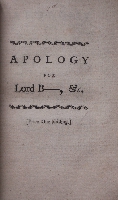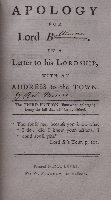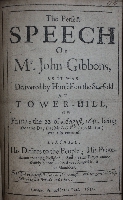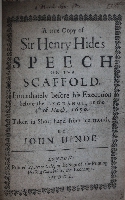English pamphlets 1649 - 1768
Year: 1649 - 1768
Edition: First edition
Publisher: various
Category: Arts &tc.
A number of 13 tracts and pamphlets, all printed between 1649 and 1768 bound into one volume late 18th century.
Contemporary half leather over paper covered marbled boards. Considerable edge wear to the boards, especially at the corners. Front cover detached but present, spine label lacking, leather getting a little dry. The spine has the mark “1” (one) in gilt, so possibly the collector who had these tracts and pamphlets bound together in this volume, owned a larger collection. Some of these pamphlets were written and published anonymously. Most of them are rare or very rare, while a few are extremely rare The contents of this volume are handwritten on the ffep. In a neat hand the names of the (supposed) writers have been added to anonymously published pamphlets. The 18th century pamphlets overall bright and clean, the 17th century ones agetoned. Unless indicated otherwise here below, these pamphlets are first editions.
The titles in order of which they are bound in are:
(1) An Exact Diary Of What Was Observ'd During A Close Attendance Upon Mary Toft, The Pretended Rabbet-Breeder Of Godalming In Surrey, From Monday Nov. 28, to Wednesday Dec. 7 following. Together with An Account of her confession of the Fraud. By Sir Richard Manningham, Kt.
Printed for Fletcher Gyles London 1726, 38 pages, final blank page.
Mary Toft was a maidservant from Godalming, England who in 1726 became the subject of considerable controversy when she was alleged to have given birth to at least 16 rabbits, according to her doctors.
Toft was 25 years old and married at the time, and despite a miscarriage in August still seemed pregnant. She went into apparent labor and the local doctor John Howard arrived to assist. Howard reported that he delivered several rabbits, all stillborn, and that afterward she still seemed pregnant. He sent letters to some of England's greatest doctors and scientists asking for help investigating the situation, and among those who came to his assistance were Nathaniel St. Andre, surgeon-anatomist to King George I, and Sir Richard Manningham, the most famous obstetrician in London. Toft gave birth to several more dead rabbits in their presence.
Toft claimed that during pregnancy she had an intense craving for roast rabbit, that she tried to catch rabbits in the garden, that she had admired them in the village market, and that she had dreamed about rabbits. Based on this the doctors explained the births as a result of "maternal impressions", contending that a pregnant woman's experiences could be imprinted directly on the fetus at conception and cause birth defects. Sir Richard Manningham eventually exposed the rabbit birthings as a hoax, but not before many of London’s most eminent doctors had been thoroughly taken in by it. In the aftermath of the hoax the medical profession received a great deal of public mockery for its gullibility. (Source: WorldHistory.com).
RARE
(2) The history Of Thamas Kuli Khan, Shah, or Sophi Of Persia
Extracted from the French.
Printed for J. Wilcox London 1740 - 35 pages
To the best of our knowledge this was extracted from vol. 1 of "L'Histoire de Thamas Kouli-Kan Sophi de Perse" by le Père Antoine du Cerceau, however, ESTC, which only locates 2 copies (British Library and Cleveland Public Library), states: "Sometimes erroneously attributed to Jean Antoine Du Cerceau".
EXTREMELY RARE
(3) Apology For Lord B----, &c.Third edition;
Complete with half title page.
Printed 1768 for W. Flexney - viii, 35 pages.
Attributed to Rob Morris (LC record in NUC [v. 396, p. 105], for this edition). Lord B. is Lord Baltimore. Apparently the two earlier editions appeared under the different title: "A Letter to Lord B---" of which ESTC locates 11 copies of both editions in total. Frederick Calvert, Maryland's six and last Lord Baltimore, in 1768 was accused by Sarah Woodcock of abduction and rape. During the trial the prosecution brought forward sufficient facts to justify the public indignation that was raised by the press, however, the jury believed that Ms Woodcock had not sufficiently tried to escape and she also had not reported the crime properly, hence Lord Baltimore was acquitted. To avoid further disgrace after the trial, he went to the continent. In 1771 he died in Napels.
ESTC only locates one copy of this third edition; Trinity College at Cambridge University. WorldCat locates one more copy in the William Clements Library of the University of Michigan.
EXTREMELY RARE
(4) A Genuine Narrative Of The Deplorable Deaths Of The English Gentlemen, and Others, Who Were Suffocated in the Black Hole in Fort-William, at Calcutta, in the Kingdom Of Bengal; in the Night succeeding the 20th Day of June, 1756
By J.Z. Holwell, Esq., second edition printed for A. Millar London 1758 - viii, 56 pages.
The notorious episode of the "Black Hole" of Calcutta furnishes an extraordinary instance of the manner in which narratives are constructed and the place of iteration in historical narratives. It points equally to the difficulty of ascertaining "truth" in history. In 1756, Siraj-ud-daulah, the Nawab of Bengal, occupied Fort William and Calcutta, then the principal possession of the East India Company. 146 people are said to have been imprisoned, at the orders of the Nawab, in a small and airless dungeon at Fort William. Next morning, when the door was opened, 123 of the prisoners had died. This story was recounted by the survivor John Zephaniah Holwell, and soon became the basis for representing Indians as a base, cowardly, and despotic people. Innumerable journalistic and historical works recounted the story of the "Black Hole" of Calcutta, but Holwell's account was the sole contemporary narrative. 146 people could not have been accommodated in a room of the stated dimensions of 24 x 18 feet, and it is now almost universally conceded that Holwell greatly embellished his story. Indian scholars have shown the Nawab had no hand in this affair, and that the number of incarcerated prisoners was no higher than 69. It may even be possible to argue that the episode of the "Black Hole" never transpired. Though for the British it became an article of faith to accept the veracity of the episode in its most extravagant and sordid form, all accounts relied, without stating so, upon the sole authority of the contemporary narrative of Holwell. As Edward Said, following Foucault, has suggested in Orientalism (1978), once something is said often enough, it becomes true. (Source UCLA, Faculty of Social Sciences)
(5) The Trial Of Katharine Nairn And Patrick Ogilvie For The Crimes Of Incest And murder.
Reprinted for T. Becket and P.A. De Hondt 1765 - v, 134 pages, final blank page.
Complete with half title page.
Marginal tear in page iii.
Thomas Ogilvie, husband of Katharine Nairn, was the murder victim.
This is the only London report of one of the most interesting and remarkable Scottish trials. Nairn was found guilty of conspiring with her brother-in-law to murder her husband. Nairn, "pleading her belly" escaped to a convent, while her lord, the murdered husband's brother, was hanged.
This sensational trial was issued in two Edinburgh printings issued the same day and this later London issue. Katharine Nairn, age 19, was convicted of poisoning her 40 year old husband with arsenic supplied by her husband's younger brother. The chief witness was the ex-prostitute lover of a third, and youngest, brother who stood to inherit the family estate upon the death of his two older brothers. Alexander, the youngest brother, did inherit the estate but was killed falling (or possibly being pushed) from a window.
RARE
(6) A Candid Narrative Of The Rise And Progress Of The Herrnhuters, Commonly Call’d Moravians, or, Unitas Fratrum; With a short Account of their Doctrines, drawn from their own Writings.
by Henry Rimius. The second edition in which the Latin appendix in the first edition is render'd into English.
Printed for A. Linde 1753 - 120 pages.
To which are added, observations on their politics in general, and particularly on their conduct whilst in the county of Büdingen in the circle of the Upper-Rhine in Germany.
Unitas Fratrum was founded by Nikolaus Ludwig Count von Zinzendorf who, in 1722, established on his estate the colony of Hernnhut to offer sanctuary to the persecuted Bohemian brothers, a religious community with its roots as far back as the 15th century somewhere in Bohemia, hence their name. The Moravians intended to remain Lutheran, however, after a conflict with the national church in 1737 Von Zinzendorf had himself ordained as bishop of the Moravians.
(7) Inoculation Of Good Sense Or An Estimate Of The Present Manners Of The French Nation.
The English title page preceded by a French one with the text:
L'inoculation / du / bon sens,
Par / E H Diderot
A Londres / Chez C. G. Seyffert en Pall-Mall
MDCCLXI
Printed for C.G. Seyffert 1761 - 55 pages (page 55 misnumbered 54).
Text both in French and in English.
'Inoculation du Bon Sens' by Sélis, Nicolas Joseph and Soret, G. Jean
ESTC locates only 4 copies; 3 in the UK (BL, Oxford, Cambridge) and 1 in the USA (Boston Public), while WorldCat reveals 2 more copies in North American libraries.
EXTREMELY RARE
(8) A Brief Account Of The Vaudois, His Sardinian Majesty's Protestant subjects In The Valleys Of Piedmont in a Letter From a Gentleman on his Travels in Italy.
Printed for R. Dodsley 1753 - 32 pages
Anonymous, but variously attributed to a Mr. Goldwin and to L. Devisme.
RARE
(9) The Speeches and Prayers Of Major General Harrison, Octob. 13. Mr. John Carew, Octob. 15. Mr. Justice Cooke, Mr. Hugh Peters, Octob. 16. Mr. Tho. Scott, Mr. Gregory Clement, Col. Adrian Scroop, Col. John Jones, Octob. 17. Col. Daniel Axtell, & Col. Fran. Hacker, Oct. 19 The times of their Death. Together with severall occasionall Speeches and Passages in their imprisonment till they came to the place of Execution. Faithfully and impartially collected for further Satisfaction.
Printed Anno Dom. 1660.
Pages numbered 26 ("To the Reader"), 1-25, 27-64, 57-76, 81-96, with some corrections in an old hand (most likely contemporary) in the latter part. There are clear typographical differences between the second part and the other two parts of this pamphlet. Taken the contents, it is quite obvious that they belong together, however, as the second part (pp. 57-76) deals only with Mr. Scott and Mr. Scroop while their speeches and prayers are not repeated, partly or in whole, in the other two parts, we are unable to conclude whether we are dealing here with the same pamphlet in another variant or with a quite different pamphlet. Collation is as follows: last signature part 1: H1,2,(H3,4), signatures part 2: H1,2,(H3,4), I1,2,(I3,4), K1,2 after which part 3 starts with: L1,2,(L3,4).
RARE
(10) The Last Speech Of Col. Eusebius Andrews, Sometimes A Lawyer Of Lincolns-Inne At The time Of His Execution on the Scaffold at Tower-hill, Thursday the 22 of August, 1650.
Printed by John Clovves 1650 - i, (1), 6 pages.
VERY RARE.
(11) The Several Speeches Of Duke Hamilton Earl Of Cambridg, Henry Earl Of holland, And Arthur Lord Capel Upon The Scaffold Immediately Before Their Execution on Friday the 9. of March.
Printed for Peter Cole, Francis Tyton, and John Playford 1649, 43 pages. Small marginal tear in last page, browned.
This work exists in at least 3 variants which are not separately noticed in Wing. Variant 1 has catchword "righte-" on D1v and lacks the marginal note. Variant 2 has catchword "Hodges" on D1v and has the marginal note. Variant 3 has the incorrect catchword "Holland" on D1v and has the marginal note (Source: Durham Library). This copy is an example of variant 2 .
On the title page someone has attributed this work to Robert Booth.
(12) The Perfect Speech Of Mr. John Gibbons As It Was Delivered By Himself On The Scaffold At Tower Hill on Friday the 22 of August, 1651. being the same Day that Mr. Love (the Minister) was also executed.
Printed 1651 - i, 13 pages.
VERY RARE
.(13) A True Copy Of Sir Henry Hide's Speech On The Scaffold Immediately Before his Execution before the Exchange, on the 4th of March, 1650. Taken in Short-hand from his mouth, by John Hinde.
Printed by Peter Cole 1650 - 15 pages.
Last page with some loss of paper, not affecting the text.
Hyde was one of 11 sons of Sir Lawrence Hyde, Attorney-General to Anne of Denmark, and accompanied Charles II to the Continent. He was arrested on his return to England.
Click on a picture to enlarge.
















